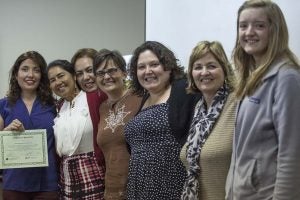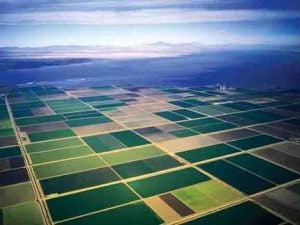
Water leaders from 13 communities throughout California’s San Joaquin Valley attended the Leadership Institute to build engagement capacity and share lessons about small water system management. (Credit: Kike Arnal)
There I was again, in the car on Highway 99, on my way from San Francisco to Visalia, in the heart of California’s San Joaquin Valley. I had made the trip a dozen times over the past year. But this trip was different. This time I was headed to a reunion.
Back in December 2016, I wrote about a cohort of 30 community water advocates who had just graduated from the Rural Water Boards Leadership Institute – a joint effort sponsored by the Rural Community Assistance Corporation, Self Help Enterprises and Environmental Defense Fund to train residents in the San Joaquin Valley on how to engage on state water policy. Participants spent six months attending workshops and learning about California’s landmark law to end groundwater over pumping and how the law – known as the Sustainable Groundwater Management Act, or SGMA – might affect their small community water systems. They discussed methods for engaging state policy makers and learned advocacy and communication skills.
Now, almost a year after their graduation, these water leaders were meeting again to catch up, share stories and explore new opportunities to learn from one another.
What’s new?
A lot had changed since their graduation. Most notably, the deadline for forming Groundwater Sustainability Agencies (GSAs) had passed. GSAs are public agencies responsible for creating and implementing groundwater sustainability plans under SGMA. Dozens of GSAs have been formed in the most critically over drafted groundwater basins in the state – many of which are in the San Joaquin Valley.
Our water leaders rely on these basins for drinking water. The small community wells that serve them are often contaminated and, in some cases, have started to run dry. The hope is that GSAs will regularly reach out and engage water leaders, giving them access to resources and the ability to contribute to overall basin sustainability.
But engagement and inclusion isn’t the norm. And while some GSAs have been directed to improve rural community outreach, it’s still up to the water leaders to make their voices heard.
[Tweet “California’s rural water systems need leaders. Who will step up next? https://www.edf.org/Xnk”]
The Water Warriors
This was a hot topic of conversation during the reunion. Ideas were shared for bridging the communications gap with GSAs and other decision-making bodies in the state. We explored the entrepreneurial mindset and the ripple effects of grassroots leadership on their communities. And we capped the day with a screening of “Water Warriors” – a video that documents the hard work community members are doing to manage their water systems.
For me, the reunion served as yet another reminder of the important role the water leaders play, not just in their communities, but to the agricultural sector more broadly. They will be key players in achieving groundwater sustainability in the San Joaquin Valley and throughout the state.
Where to next?
Problems facing small community water systems are not unique to the San Joaquin Valley. According to a report from the State Water Resource Control Board [PDF], nearly 1.2 million people are served by small water systems that serve fewer than 3,000 people each. (For comparison, the typical urban water system serves at least 10,000 people.)
All of these small water systems need leaders. That’s why we will be launching the next iteration of the Leadership Institute in January 2018. We’ll start by cultivating and strengthening local leadership in the Imperial Valley, a region in the southeastern corner of California. Known for its large-scale farms and year-round agricultural production, the area is also home to many small communities that are groundwater dependent.
From there our hope is to expand the institute to communities in every corner of the state, and to build a network of graduates that can support and advocate for each other.
It’s our job to arm water leaders with the skills and knowledge needed to bridge the communications gap and make their voices heard. Let’s get them the resources they need to succeed.
Related:
Water heroes emerge in California’s Central Valley >>
Sunshine, beaches and…saltwater intrusion? Solving for groundwater decline on California’s coast >>
Teetering on the edge of disaster. What’s next for the Salton Sea? >>











One Comment
I would keep in mind those small communities are dependent on agriculture.